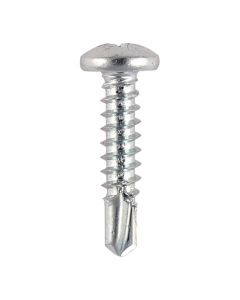How Do I Select Suitable Self-Tapping And Self-Drilling Screws?

Self-tapping hinge screws allow the screw to tap into its hole while it is being driven into it. You can choose from a blunt, flat or sharp tip. For drilling holes in soft materials, sharp-tipped self-tapping screws can be used.
The self-drilling screws work on the same principles that drill bits and other cutting instruments. The way these screws are used will affect their performance just as much as how they were designed.
When choosing self-tapping masonry screws, two essential considerations are material thickness and the type of materials to be combined. When choosing a suitable self-drilling fastener, there are key design features to consider
Drill Flute
The drill flute’s length determines how thick metal can be drilled. Drill flutes permit the drilling material to exit the hole.
The drill chips can clog the flute, causing the cutting action to stop if the drill flute is wholly embedded in the material. This could lead to the drill point becoming too hot and causing it to fail.
Point Length
The drill point is the section that runs unthreaded from the drill point to the first thread. This section must be long enough for the threads to penetrate the material. Too early engagement can result in the fastener forming a bind or breaking.
Screw Wings
Fasteners that are more than 1/2 inch thick must have wings to attach wood to metal. The wings will create a clearance and prevent the threads from contacting too soon.
The threads will engage once the wings touch the metal material. The threads could become too engaged early and cause separation of the base and fastened material (jacking).
Self-Tapping Screws
Before the flat-tipped self-tapping screws can be installed, a pilot hole must first be drilled. Self-drilling screws can also be used with some self-tapping screws.
These screws feature a flute-like tip similar to a drill and the tap-like flutes in the leading threads. These screws are highly efficient for challenging substrate applications.
How Self-Tapping Ability Is Created?
This is often done by cutting a hole in the continuity of the threads on the screw. This creates a flute or cutting edge that looks similar to those on a tap.
Soft Substrates – Wood Or Soft Plastics
The self-tapping ability can come simply from a tip that tapers to a gimlet point (no flute is needed); the end forms the hole by displacement of the surrounding material rather than any chip developing drilling/cutting/evacuating action.
Self-Drilling Screw VS Self-Tapping Screw: What’s The Difference Between?
Many people ask about the differences between self-tapping screws and self-drilling screws. Although self-tapping screws can create their threads, they aren’t designed to make their holes; they do create their threads.
Screws for metal studs can be used with soft materials like wood or plastic to create their threads and tap the desired thread.
Types Of Self-Tapping Screws
There are generally two types of self-tapping screws: thread-forming or thread-cutting.
A blunt tip is required for a thread forming self-tapping screw. These screws need a pilot hole slightly smaller than the diameter of the screw shaft. These screws are used to join together plastic materials tightly using thread forming. Overtightening can cause damage.
The pointed tips of thread cutting self-tap screws are available. They don’t usually require drilling a pilot hole, but this is sometimes a good idea.
Many types of self-tapping screws are available, including button-heads, countersunk, pan-heads, hex heads, and many other styles. It would be best if you chose the right self-tapping type for your fastening task.
Self-Tapping Concrete and Masonry screws
Self-tapping concrete screws and masonry screws are great examples of how self-tapping technology can be applied to practical applications.
Mirror screws with caps technology is widely used to attach all kinds of items to brickwork and blockwork. It can be used for everything, from security anchors to washing lines.
Self-tapping masonry screw requires that a pilot hole be drilled in the substrate smaller than the screw’s diameter. This is possible in brick, stone and blockwork with a hammer drill. As it is screwed in, the self-tapping brick screw will cut its thread.
Self-Tapping Screws For Plastic
Plastics are very rigid and can easily split and crack. It is important to drill pilot holes in the substrate to allow for self-tapping screws to be installed. Standard self-tapping screws are fine for most plastics.
However, there are special self-tapping screws for plastics with more prominent and sharper threads. This creates a more robust fastening that is less prone to being pulled out or thread-stripping.
Wood Self-Tapping Screws
Pilot holes are not required when using self-tapping screws to fasten to softwoods. However, pilot holes should be drilled if self-tapping screws are used with hardwoods.
Consider the material of the exterior coach bolts as moisture can lead to corrosion. Stainless steel and corrosion-resistant self-tapping screws are highly recommended.
Self-Tapping Screws For Metal
Pre-drilled pilot holes will be required when self-tapping screws are used in metal. Self-tapping screws should be used in more challenging metal substrates than the metal to which they will be attached. This could cause damage to the self-tapping screws and lead to insecure fixing.
How To Use Self-Tapping Screws?
These are some effective tips shared with you to help use different screw effectively. Make sure you choose the right kind of screw for your project.
Self-tapping masonry screws can be used to attach things to concrete or stone. If you need to join two pieces, then self-tapping screws for plastic are required. If necessary, drill pilot holes with the correct diameter. Some materials require pilot holes to be prepared for self-tuning screws. Never drill holes that are larger than needed.
Make sure the stainless steel screws are aligned correctly. It is essential to align the self-tapping screw correctly before you insert it and tighten it. Before you screw in the self-tapping screws, make sure they are perpendicular to the pilot hole.
Last Thoughts
Combining screws and nails is a winning combination. You get a high-quality, durable fastener that will last for many years. It also enhances the aesthetic. Preserved wood is a high-quality, long-lasting fastener that will not succumb to insects, rot, or fire.




